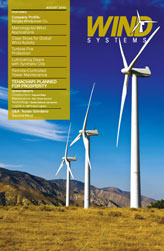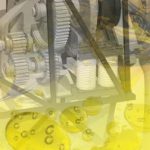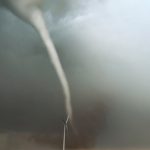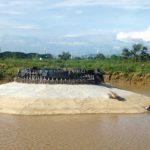The Tehachapi area is considered the birthplace of wind in North America, and as we celebrate the 30-year anniversary since the first turbines were installed you can expect to see more milestones. Repowering and new development will flourish thanks to the first-of-its-kind transmission line and a 20-year contract with Southern California Edison. It represents the largest wind energy contract ever signed by a United States utility.
Decades of Delivery
A number of wind farms call Tehachapi home, including Terra-Gen Power, enXco, NextEra, Cal Wind Resources, Coram, Oak Creek Energy Systems, GE Energy, AES, Mogul Energy, and Windland. It’s been three decades since the first wind turbines were installed in the Tehachapi-Mojave Wind Resource Area. It is considered one of the premier places in the nation for wind power, and one of the windiest places in the world. The winds average 14 to 20 miles per hour through the pass from one year to the next, and they vary with the terrain, season, and time of day. Average wind speeds approach nearly 9 meters per second (about 20 miles per hour). This places much of the Tehachapi Pass in wind power class 6 (these classes range from class 1, the lowest, to class 7, the highest).
The first turbines erected in Tehachapi were about 45-60 feet in height, and they produced about 25-60 kilowatts. Today they stand about 400-500 feet, producing about 1-2.4 megawatts. The area is enjoying a new breath of life thanks to the new transmission line and a 20-year contract with Southern California Edison and Terra-Gen Power for the Alta Wind Energy Center, 1,550 megawatts (MW) of wind energy development. It represents the largest wind energy contract ever signed by a United States utility, and it also means that wind developers have better access to the California grid and the ability to sell to multiple utilities.
It also represents a major hurdle since a group of visionaries installed the first machines in the early 1980s. Multiple generations of wind turbine technology are still up and running in Tehachapi. There are the single- and double-blade turbines that generate between 25 and 60 kilowatts, to the more modern three-blade turbines that generate up to 4 megawatts. It’s four generations of turbines with an installed capacity of about 785 megawatts.
A lot has happened since the first machines were installed. After overcoming numerous regulatory hurdles, SCE officially began the construction of its Tehachapi Renewable Transmission Project (TRTP). The first phase of the TRTP cost $1.8 billion and will ultimately result in a high-voltage transmission system capable of delivering 4,500 MW of clean energy into the Los Angeles metropolitan area, which is located about 100 miles south of Tehachapi. Executed power purchase agreements to date will allow up to 1,500 megawatts or more of power generated from new projects to be built in the Tehachapi area. It represents the first construction of a “public” transmission line that carries electricity generated at the park straight to the grid. This state initiative to upgrade the transmission out of Tehachapi began in 2008 and is expected to be completed by 2012. It has proved to be a catalyst for multiple projects including: Coram Ridge, consisting of 34 Vestas V90s, developed by Coram Energy Group & Brookfield Renewable Power; Windstar, consisting of four Gamesa G52s, 37 G80s, and 16 G87s, developed by Western Wind Energy; and Alta I-V, consisting of both GE 1.5s and Vestas V90 Turbines, developed by Terra-Gen Power. The Windstar project, whose general contractor is RMT, will bring the first Gamesa turbines to the region. These projects are all slated to see construction begin in 2010.
According to SCE, the TRTP will allow them to more than double its wind energy portfolio and envisions connection of more than 50 square miles of wind projects in the region, which is triple the size of any existing U.S. wind farm area. Officials estimate that it will eventually provide 4,500 megawatts of electricity, which could make it the largest wind project in the nation. The new wind farms are expected to eventually comprise 1,750-2,000 turbines. Not only does this triple the size of any existing U.S. wind project, but it is also expected to outperform the world’s current largest wind farm. Phase 1 of the TRTP, which includes segments 1 through 3 out of 11 planned segment improvements, is expected to be completed in 2010. Figure 1
Randy Hoyle, vice president and head of wind development for Terra-Gen Power, LLC, has this to say. “Terra-Gen Power is excited to be the first renewable energy company to utilize Southern California Edison’s (SCE) newly constructed Tehachapi Renewable Transmission Project. The 720 MW first phase of the project will increase California’s installed wind capacity by nearly 25 percent and contribute substantially to the state’s renewable energy needs.”
The transmission line has definitely strengthened the industry here. “According to the Kern County assessor’s office, by the year 2030 the wind industry will have assessments equal to that of the oil industry in Kern County,” says Linda Parker, executive director of the Kern Wind Energy Association. “This is a big deal. We never imagined when we started that we would rival the oil industry.”
The approval of the TRTP is a notable exception to difficulties with long-distance transmission in America. In fact, it’s the first major transmission project in California being built specifically to access renewable generators in a remote, wind-rich resource area. “Prior to that system coming we weren’t growing, and we weren’t going to. We couldn’t take one more watt,” says Parker. “The construction of the transmission line is a major accomplishment that many people have worked tirelessly on. It gives the wind industry options and the ability to contract with other electric utility companies.”
Collaborative Construction
Numerous entities, companies, and individuals played a major role in the conception, planning, development, and approval process for the transmission project, which has involved a number of precedent-setting decisions, both regulatory and in the courts. It is showing the way and sets an example for other badly needed transmission infrastructure projects in this country. Hal Romanowitz, president and COO of Oak Creek Energy Systems, was one of these key players. He says it is important that transmission expansion facilities be well planned and scaled to serve the large regional needs if they are to succeed. Figure 2
“TRTP progressed from our local development and planning efforts into the state-wide planning, and on top of that it took five studies to get the right focus onto a solution that was good for the entire state, not just a limited group, and the TRTP that is being constructed is very good for serving a substantial range of clean energy projects and to the overall grid reliability as well,” Romanowitz says. “TRTP planning in California was the start of a superior process for regional planning that continues and which will ultimately do well for the electric needs of the state on a proper scale.”
“Getting the transmission expansion scaled to the proper level and getting the costs rolled into rates paid by users of the system is extremely critical,” he continues. “This is one of the biggest problems blocking transmission expansion success across the country. To be proper, such user funded expansion needs to be part of a regional transmission planning process so that the expansion is properly scaled and will best serve broad needs. One issue is that in some states users are strongly objecting to pay for transmission used to transport new renewable energy across their state to others in remote locations. A strong national transmission grid is critical for our country, however, and we are not getting what we need with so much provincialism.”
Edison is not the only utility involved. As other utilities embrace wind power, the recently completed Pine Tree Wind Project is another example to note. The Los Angeles Department of Water and Power just brought the Pine Tree Wind Project online after overcoming significant obstacles during the project development and approval process. In a project implementation process that began in earnest in 2003, LADWP has added 120 megawatts of wind to its distribution grid. “It’s another precedent,” Parker notes, “Los Angeles coming to Kern County for wind.” Figure 3
The Pine Tree project is able to deliver energy directly into existing LADWP transmission system lines that already run through Kern County to bring in hydro-electric power from points north. In these times of droughts and reduced production from hydro projects, it’s a great match of complementary clean technologies.
A key player in this project is AECOM, a global leader in renewable energy. The international consulting firm assisted LADWP with implementation of the Pine Tree project by conducting the initial resource surveys and constraints analyses, preparing environmental documents meeting both federal and state laws, preparing applications, and providing assistance to LADWP to obtain regulatory and land use permits. The firm also provided resource monitoring support and compliance services during project construction. Prior to the beginning of construction, LADWP had to secure 12 regulatory permits containing nearly 400 separate mitigation measures and conditions of approval.
“The development process for Pine Tree had to face numerous regulatory challenges, including endangered species, federal, state, and local agency involvement, military flight corridors, and a lawsuit by an environmental group,” says Jane Chang, an environmental planner in the Irvine, California, office of AECOM.
Power Permitting
Though the process of permitting wind energy in Kern County has been generally good, like anyplace Tehachapi has its share of permitting issues like anyplace, and they’re getting even tougher according to Ed Duggan, executive vice president of Oak Creek Energy. “The biggest challenges facing wind energy development in Tehachapi and elsewhere in California are environmental concerns that seem to be running somewhat amuck and government agencies that are afraid of being sued as a result.”
For example, the recent success of the California condor breeding program has resulted in concerns about this endangered species expanding into the Tehachapi Wind Resource area, and this has resulted in recent calls to restrict development here.
“If it’s not the condors on the mountain ridges, it’s the desert tortoise and ground squirrel on the flats,” Duggan says. “The problem is that some environmental groups seem to be focused on single issues and not looking at the big picture. The reality is that there are risks and consequences from all types of energy generation—just look at the environmental disaster in the Gulf of Mexico being caused by oil right now.”
We need to push permitting agencies to look at the big picture and factor in the national security benefits of home-grown energy and the potential of mitigating global warming, and job creation. Luckily, the county and the community seem to get the big picture. “One of the great things about Tehachapi is that the wind industry has been here for so long now that we have a lot of people rooting for us,” Duggan observes. “The businesses, residents, and government leaders have long recognized the benefits of wind.” Figure 4
It’s this support from government officials, residents, and stakeholders that has allowed companies such as Oak Creek Energy Systems (OCES) to endure the real test—time. OCES is a wind energy pioneer that began in the early 1980s and developed one of the first projects in the Tehachapi area. The company has long played an active role in the wind energy industry and was instrumental in advancing wind progress and policies. Steve Cummings, who is my father-in-law, is the former president and founder of Oak Creek. He installed some of the first wind turbines in Tehachapi, and in North America for that matter. He was also the first president of the Kern Wind Energy Association.
He describes some of the hurdles his generation faced. “At that time there wasn’t a lot of product availability, so you had to take what you could get,” he says. “You may want a certain turbine, but it might not be available for more than a year. The American manufacturers had to play catch-up since the Danish had a head start. Plus we not only had to import turbines from other countries, but we had to bring the technicians over, too.”
Avoiding Conflict
Tehachapi leaders were also the first to realize that proper planning and engaging stakeholders would help preclude conflict, and today we all benefit from the ongoing public dialogue that started back in the 1980s. “The county was fairly easy to deal with back then,” says Jim Watkins, a wind energy consultant and one of the early pioneers in the Tehachapi wind industry. “Since this was unprecedented there weren’t any guidelines, so they established an ad-hoc committee that consisted of people from the wind industry and environmentalists, which proved to be very helpful,” he says. “Since this was all agricultural land we had to create new guidelines and zoning, and we didn’t have a model to follow—we had to create the model.”
Of course the federal and state tax credits played a major role in spurring the wind energy industry back then. Some of the first companies include Zond, Oak Creek Energy, WindLand, Windridge, SeaWest, Difko, FloWind, Cannon, CalWind Resources, Mogul Energy, and AB Energy, just to a name a few, although many of these original companies have sold or changed their name.
“For the first four years it was all about the tax credits, and when they expired this was a major setback,” Cummings recalls. “The machines could not stand on their own. Since no one had contracts with SCE, we had to hammer these out. In my mind this was the most challenging aspect. It wasn’t so much an infrastructure issue since they were able to carry the loads we were producing pretty easily. It was more of a negotiating issue. Initially there was a lot of discontent between the wind industry and Edison. I can remember our first dealings well. A question would come up and we didn’t have an answer. There were long moments of silence in those meetings when no one knew what to say. This was new to everyone.”
Pioneers like Cummings definitely paved the way. Thanks to the concentration of wind, its second largest industry, Tehachapi has been responsible for impacting the wind power industry on a national and global level. Founder of Zond—a Tehachapi-based turbine manufacturer that was acquired by Enron and ultimately GE—Jim Dehlsen and his son James went on to establish Clipper Windpower, which has become a major turbine manufacturer worldwide and is one of few American-based manufacturers. Figure 5
In addition to manufacturing, Tehachapi has spurred construction businesses including Wind Energy Constructors and World Wind Services, whose CEO is a second-generation wind power entrepreneur and is one of the few women owned business in the industry, as well as the highly acclaimed wind technician training facility, Airstreams Renewables. “More capacity and less impact are the key changes since wind was introduced here,” says Parker. “I should point out that yesterday’s technology is not today’s technology. We have fewer turbines that produce more energy, yet we have fewer access roads and intrusions to the land. Since the 1980s we’ve progressed to a technology that’s competitive with the rest of the world.”
What does the future hold for this wind-rich region? Repowering and new development are sure bets. Duggan breaks it down: “Oak Creek is an example of a wind project that is repowering and producing more energy as a result,” he says. “This repowering of smaller turbines with bigger, more efficient turbines has been going on for over 10 years now and it will continue at Oak Creek and on other older existing wind farms until most of the early eighties generation of turbines, which are now approaching 30 years in age, have been replaced.
“The potential upside of newer, bigger, better turbines is too great to ignore. As far as new development goes, we’ll see a lot more on the Mojave side of the Tehachapi Pass and a little more on the Tehachapi side, but much of the new capacity will also be in the nearby Antelope Valley area,” he says. “This region will grow to about 4,500-5,000 megawatts of total capacity in the next 5-10 years; it’s going to happen quickly. After that we’ll continue to expand at a slower rate, and by the year 2040 we should be somewhere around 10,000 megawatts of total capacity.” Figure 6
Future Developments
A look back reveals that some of the same challenges we faced then are the same challenges we’re facing today—regulatory hurdles, environmental concerns, costs, and negotiating with the utilities. Another thing that isn’t expected to change—expect Tehachapi to continue to lead the way when it comes to both wind power and solar. The rapidly expanding list of solar power project applications and plans includes as many as 63 developers because this also happens to be one of the four best regions for solar development in the world. The actual amount of proposed or planned wind projects is hard to ascertain, but some reports suggest this area could accommodate more than 40,000 megawatts of proposed renewable projects. That’s two thirds of California’s grid capacity and enough electricity to power more than 20 million homes.
Note: A Tehachapi native, Cummings is currently serving as president on the board of directors for The Wind Energy Center and a board member of the San Diego Chapter to Women of Wind Energy. She was also one of the nominees for the 2009 Rising Star Award for the Women of Wind Energy Association.








































